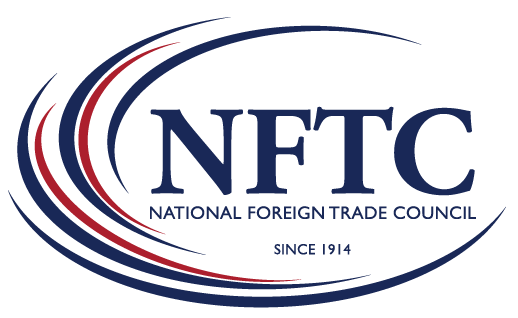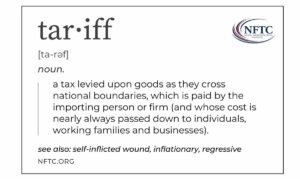By Melissa Alvisi, Fellow, International Supply Chain Policy and John Pickel, Vice President, International Supply Chain Policy
Rather than encouraging investment, current and proposed tariffs are delaying growth, disrupting operations, and raising legal concerns among companies, according to a recent survey of industry-leading companies conducted this spring by the National Foreign Trade Council.
While the Trump Administration contemplates various additional tariff actions as a potential tool to drive U.S. trade and manufacturing policies, economists and industry experts warn of broad potential impacts on supply chains. If carried out, these actions could limit availability of base inputs like active pharmaceutical ingredients (APIs), crucial for producing everyday medications, including baby medications, specific rare earth elements needed for electronics like smartphones and electric vehicles, and advanced semiconductors and memory chips that power everything from home appliances to medical devices. In response, businesses are being forced to adapt to a largely unpredictable landscape defined by announcements followed by temporary pauses that may or may not be extended based on trade negotiations that may or may not be durable.
Initial Effects: Increased Costs and Uncertainty
Across all industry sectors, 94% of respondents reported that procurement of raw materials is the most affected part of their supply chain, a particularly concerning finding given that many key components are not readily available in the United States and building domestic capacity is a long-term effort. Almost 90% have seen impacts to manufacturing and production capacity, while 76% pointed to warehousing and aftermarket services, such as repairs.
Tariffs are also consuming available capital that would otherwise be used to invest in employees and strategic growth. Almost half reported that tariffs impact workforce policies, including hiring, promotion, or training.
In sectors like advanced manufacturing, the stakes are particularly high. Four in five companies said tariffs threaten their ability to innovate in areas critical to competitiveness, from fuel efficiency to safety and sustainability. “Service providers [like customs brokers] are overwhelmed and can’t keep up,” one says, adding that, “goods do not get cleared [to cross the border and enter the U.S. economy] in a timely manner and freight must stay on ships or at the ports.” Delays then contribute to port congestion and competition for limited warehouse space, ultimately leading to product shortages.
Information and communications technology firms have also felt the pressure. Three-quarters warned that tariffs are driving up prices and reducing consumer access to affordable products. “Many customers have anchored their decision timing to key dates in the administration’s timeline, such as after the 90-day pause on reciprocal tariffs,” said one respondent. But with trade talks not progressing uniformly, there are growing concerns that major trading partners may not finalize deals within the expected window, deepening uncertainty for both businesses and consumers.
In the food and beverage sector, companies face tradeoffs between absorbing costs and compromising standards. They anticipate tariffs will impact companies’ ability to maintain food safety and quality standards, invest in sustainability, and keep prices stable.
Across sectors, the uncertainty is constraining capital that could be directed towards productivity-enhancing investments such as advanced manufacturing and R&D. Bolstering domestic competitiveness should focus on encouraging such investments rather than mitigating tariff exposure.
Reducing Offerings, Delaying Projects
Another concern related to current tariffs highlights a lack of availability of natural resources in the United States, which greatly impacts the U.S. operations of the food and beverage industry. This is just one example of why NFTC supports flexibility on tariffs for essential imports which ultimately feed into U.S. manufacturing.
Tariffs on selected sectors jeopardize the Administration’s stated goals in sectors such as lowering energy costs and AI dominance, and its desire to create a production economy in the United States. While businesses want to bolster U.S. manufacturing in support of the Administration’s objectives, tariffs on key components ultimately create bottlenecks to new construction. Without timely access to affordable inputs, prices inflate and projects are delayed.
This uncertainty is prompting tough decisions, hindering production capacity and product choice. More than half of respondents have indicated that they are reducing current product and service offerings, or delaying new product rollouts or services into the U.S. market. Others are pausing or stalling expansion projects altogether, waiting for more consistency in tariff exposure, in hopes of a more favorable climate or an exclusion process for inputs or products that can’t be obtained domestically.
Responses also showed that close to half of our companies have scaled back, or anticipate to scale back, their U.S. operations, and 30% stated their supply chain partners plan to do the same. As a reaction to the current and proposed tariffs, companies are making difficult decisions that risk challenging innovation and weakening U.S. competitiveness, and many are reevaluating their long-term strategies.
Creating Durable Solutions
To support U.S. manufacturing, the Administration has an opportunity to accelerate its dealmaking with America’s major trading partners while creating a more flexible and strategic framework governing the use of tariffs.
While companies are preparing for updates related to the administration’s trade negotiations and waiting for details of discussions with China, India and the UK, they are also considering new strategies to help them navigate layered tariffs. Three quarters of respondents reported that uncertainty hinders their ability to invest in U.S. operations, provide the products and services the customers want. For some, the current environment may mean higher investment in their internal capacity to identify and mitigate risks and increased compliance costs.
International partnerships are critical as companies diversify supply chains. As tariffs are increasingly used to rebalance bilateral trading relationships, U.S. policymakers should adopt a more structured and strategic approach. This includes (1) articulating clear objectives and defining measurable outcomes for trading partners, (2) exempting products not commercially available domestically or implementing phased measures, and (3) establishing a “review and adjustment” process to reassess tariffs based on success metrics or unintended impacts. Targeted incentives for U.S. manufacturing (such as tax incentives, workforce development opportunities, and favorable investment policies) remain essential.
Finally, the findings above highlight the less visible and often-overlooked impacts of tariffs on large companies, their suppliers, and American consumers. It is likely that these impacts are more acutely felt by small businesses, which generally have less opportunity to shift sourcing, negotiate contracts, and spread the capital-depleting impacts of tariffs.
Businesses build compliance programs and commit to sourcing contracts in advance and for long periods. The current flurry of tariff announcements – including frequent changes, often with little notice – raises opportunity costs, which can reduce innovation and stall productivity. This volatility also undermines strategic planning and jeopardizes the competitiveness of U.S.companies operating domestically and around the world.






